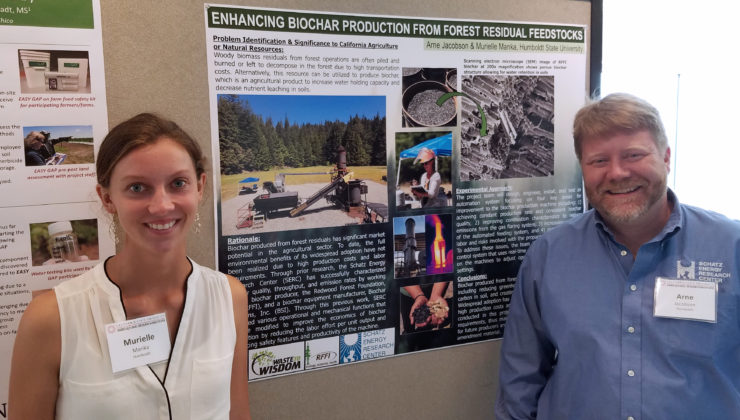by Kyle Palmer and Mark Severy
For the past three years, the Redwood Forest Foundation, Inc. (RFFI) has produced biochar from small-diameter tanoak trees collected from thinning operations in Mendocino County’s Usal Forest. The Usal Forest ecosystem was disrupted by industrial logging operations throughout the 20th century. Tanoak’s rapid regrowth dominated canopy light, and interfered with redwood repopulation. RFFI is selectively removing tanoak to create the natural space that redwood needs to flourish, and converting the tanoak into biochar to help fund their restoration work.
Biochar, a blackened, solid biomass produced at temperatures above 500°C in the absence of oxygen, is used primarily as a soil amendment to increase water holding capacity, reduce nutrient leaching, and improve conditions for microbial life. (Learn more about biochar on the Waste to Wisdom site.)
RFFI’s biochar production operation has balanced on the edge of technical and economic feasibility due to the high moisture content of the tanoak feedstock and the labor costs required to operate the machine. In 2016, the Schatz Energy Research Center addressed moisture content by installing a biomass drying system that uses waste heat from the biochar machine. This year, the Schatz Center is working to reduce labor hours while improving safety and productivity, by automating key processes on the machine.

In July and August, research engineers Kyle Palmer, Andy Eggink and student research assistant Murielle Manka evaluated baseline labor hours, biochar production rate, and biochar quality produced with the existing system. Throughout these tests, real-time data were collected for gas flow, composition, and electric power demand to help develop the control schemes. Monitoring and automation equipment are currently being installed and performance improvements will be validated in the coming months.
The preliminary results from this study were presented in early September by Murielle Manka and Schatz Director Arne Jacobson at the Agricultural Research Institute’s (ARI) principal investigator’s meeting in Sacramento. Validation test results analyzed this autumn will quantify benefits of the automation system, including any reductions in labor, increases in throughput, and changes in biochar quality.
This material is based upon work supported by California State University Agricultural Research Institute and a grant from the U.S. Department of Energy under the Biomass Research and Development Initiative program: Award Number DE-EE0006297.















